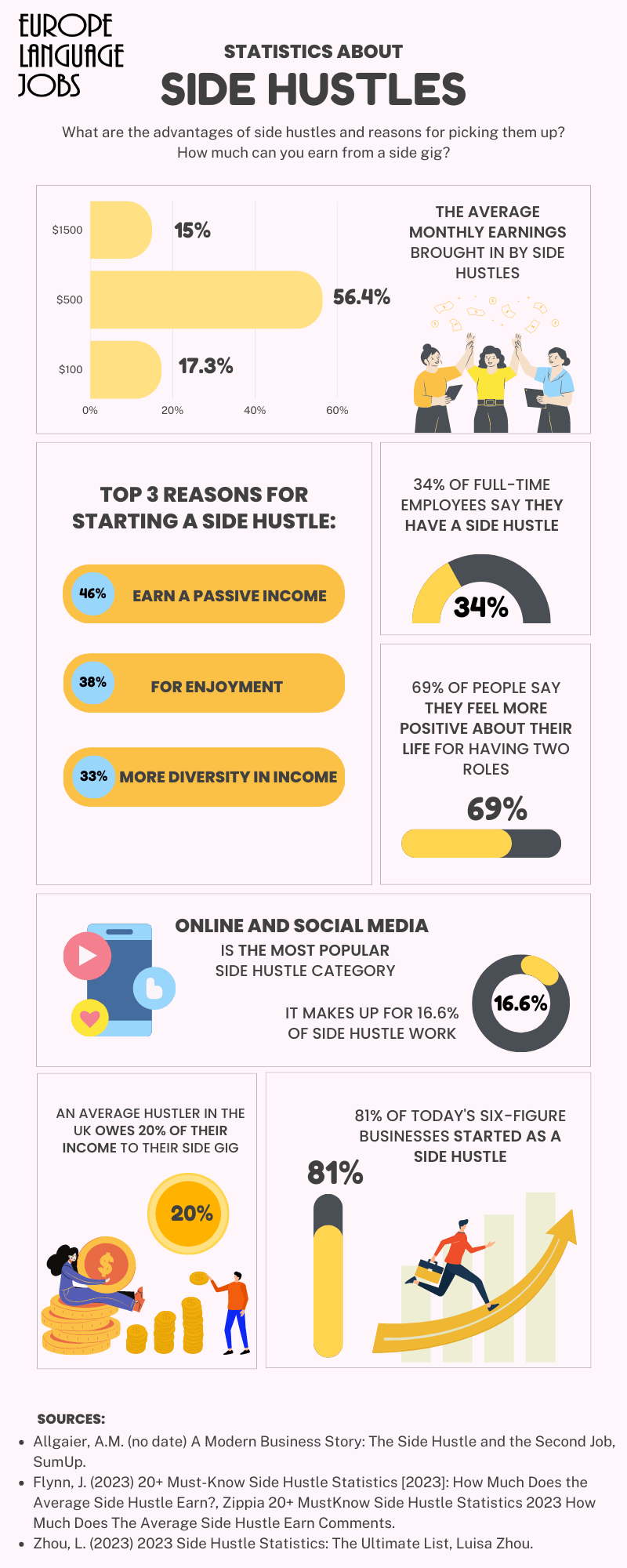Side hustles continue to be a grey zone for many. Despite their rapid gain in popularity, especially in recent years, there are still doubts about how they’re perceived by employers.
Is it okay to have a side hustle next to a full-time job? Should I be open about it? Should I keep it a secret?
We will answer all of these questions - and more! - in our article.
2. Why do people pick up side hustles?
3. Who picks up side hustles? Side gig demographics
4. What is the most profitable side hustle?
6. Disadvantages of a side hustle
7. How to start a side hustle?
8. Conclusion: Is it okay to have a side hustle alongside your main job?
What is a side hustle?
First of all, let’s make sure we’re all on the same page here. How do we define a side hustle?
A side hustle is an activity carried out outside one’s main job that delivers financial benefits. So, for example, a full-time accountant interested in pottery could be selling his or her products online. Or, a marketing manager in a global company could be running an independent social media consultancy business outside of their working hours.
A side hustle may but doesn’t have to be related to one’s main field of work. The type of activity we pick up depends on personal preferences, strengths, hobbies, and the demand on the market.
Why do people pick up side hustles?
The reasons for starting an independent business activity vary. Some do it to pursue their passions, others need the extra side income. According to Zippia, the 3 main reasons for picking up a side hustle are:
-
Earning passive income (46%)
-
For enjoyment (38%)
-
Seeking more diversity in income (33%)
In today’s turbulent economy and the era of recession accompanied by mass layoffs, it’s no wonder that many people need the safety blanket in form of a side hustle. An additional passive income is a means of ensuring financial security, which can often no longer be provided by just a full-time position in a company.
Who picks up side hustles? Side gig demographics
The statistics regarding the representatives of different ages and gender in the side hustle activity are interesting. When it comes to gender, it is estimated that 44% of men and 37% of women are involved in some type of a side gig. Therefore, men are 19% more likely to pick up a side hustle than women.
What’s more, men are reported to earn more from their side hustles than women. It is no secret that the gender pay gap still very much exists across all countries and sectors, but it is surprising that this also applies to side gigs!
On average, men tend to earn $218 more every month from their side hustles than women. This is ironic, considering that 61% of women admit they would struggle financially without their side gigs to help them.
Age-wise, the data varies. Some sources prove the general assumption and demonstrate that those between 18 and 35 years old (Millenials and Gen Z’s) are the most likely to have side hustles. A study by Zippia reports that half of them (49%) say they are involved in some kind of a side gig.
The numbers are lower for those aged 55 and older (Generation X’s and Baby Boomers), with 1 in 3 (27%) representatives of these generations admitting to working on a side hustle.
This data is confirmed by a similar study performed by Luisa Zhou. According to it, 70% of Gen Zers admit to having a second job, outside their main one. Interestingly, only 16% of them pick up a side hustle to save money. Their main motivations for getting involved in side hustles are to cover their daily expenses and splurge on an occasional whim.
At 31%, it is the Millennials who are the most likely to engage in extra activities with the sole aim to save money. Growing up in the era of financial recession might have sensitised them to the necessity for financial stability and woke up a need to make sure they don’t find themselves in the situation their parents did years ago.
Speaking of their parents, only 18% of Baby Boomers appoint saving money as their main reason for starting a side gig, according to Luisa Zhou.
Interestingly, a study by Wonolo contradicts all of the data discussed up until now. The source appoints Gen Xers and Baby Boomers as the two generations most involved in side gigs!
They explain it by the increased focus on retirement, the closer the representatives of those two generations get to it. Authors of the study believe that those nearing retirement worry about their financial stability and try to gain additional income and save up as much as they can, while they’re still professionally active.
What is the most profitable side hustle?
We won’t get into detail about the advantages of certain types of side hustles over others. However, it is pointing out that the most lucrative side hustle identified by Luisa Zhou is in the real estate sector! The average earnings of side hustlers in this sector amount to $29 012 (assuming that an average of 6 hours is spent working on this side gig every week, this translates to $90/hour).
When it comes to the most popular side hustle industry, Zippia identifies it as the Online and Social Media category. It is estimated to make up 16.6% of total side hustle work among all sectors.
To make profit if you have to price your services appropriately. As such it’s important to generate custom estimates for your projects, and use them to win clients, whichever industry you focus on.
Benefits of a side hustle
Why start a side hustle? Is it worth having a side hustle? The number of results for these queries in Google comes in millions, and their search volume goes through the roof.
So many are willing to engage in a side gig, but have doubts about whether the pros outweigh the cons. Here are some general advantages of starting a side business to help you make up your mind:
2. Job security
3. An opportunity to turn your passion into money
4. Increase your satisfaction with your professional life

1. A source of extra income
20% of the income of an average side hustler in the UK comes from their side gig. And 40% of Millenials claim money made through their side hustle constitutes at least half of their total monthly earnings.
Let that sink in.
Of course, that is not to say that all side hustles are a guaranteed way to make you a millionaire. According to a study by The Motley Fool, the median income of a side hustler is $200. Still, who wouldn’t want an extra $200 a month? If you multiply it by 12, you get the nice sum of $2400 a year.
Moreover, the average income of a side hustler is $686. Of course, measuring this type of statistic is more reliable, as it gives more realistic data. However, the elevated average is the result of a small number of side hustlers pushing up the numbers with their exceptional results. Who says you can’t be one of them?
Here’s how the statistics regarding the average income of side hustlers pan out:
-
A majority, 56.4%, make less than $500/month
-
17.3% make less than $100/month
-
Only up to 15% make more than $1500/month
The good news is that the percentage of side hustlers earning more than $1500 a month has doubled between 2020 and 2021. In 2020, the number of the lucky few equalled as little as 5%. The year after, it rose to 15%.
2. Job security
If you’re more down-to-Earth and see a side hustle more as an opportunity to create a safety net for your career while making some money, then this benefit is likely to speak to you the most. A side hustle is the new form of job security. This is how many perceive it.
Here is how side hustlers report distributing the money they receive from their side gigs:
-
35.4% use it as extra disposable income,
-
31.3% use it to cover regular living expenses,
-
28.1% allocate it to a savings account.
This means that while some people need the extra money to keep up with basic living expenses, many can actually afford to save it for emergencies. This is a nice perspective to have - that investing time and effort will reward you with some extra cash that might make your life easier in the face of unexpected expenses, or fund you a nice holiday.
Additionally, while a side gig requires your attention and dedication outside of working hours and generates extra tasks, it creates a protective shield around your career. It might be tiring sometimes to come back home from your regular 9-5 job, only to have to spend another few hours developing your side gig.
However, in case you were unexpectedly laid off, you would have a plan B to push you through. 2 in 3 full-time independent workers feel more secure than they would be working for someone else. A side hustle may not generate enough income to fully support you without a full-time job, but it will definitely be a huge help in pushing you through while unemployed.
The extra savings your independent activity has generated would pay your bills until you found a new job. Without an office to go to every day, you might also be able to dedicate more time to your side gig, increasing the revenue it brings. Who knows - maybe you’d even decide you don’t actually want to go back to working for someone else, and would try to get involved with your own project full-time.
Actually, did you know that it is estimated that 86% of today’s six-figure businesses started as side hustles? If you have a unique idea, enough entrepreneurship skills, and lots of endurance and patience, one day your side gig might be on everyone’s lips!
3. An opportunity to turn your passion into money
Did you know that only 27% of graduates work in an area related to their degree? This is a depressingly low number.
This statistic tells us that very few people are actually lucky enough to be able to work in their chosen profession. What’s more, so many of us are not happy with the degree or career path we have chosen, and realise later on in life that we’d rather do something else.
Starting a side gig is the perfect way to do what you love without needing to go through the hassle of a career change.
Monetising your hobby does sound alluring, doesn’t it? If you’re good at something and have identified a niche there is demand for, why not make money from it? 55% of people claim they would like to turn a hobby into a side hustle one day, and 73% think about quitting their main job. There’s no reason to wait!
If you’re not entirely happy in your main job but don’t want to risk leaving it completely without knowing if you can make a living off a hobby, start by turning it into a side hustle. Perhaps you do enjoy your job but would like to do something more - that’s also a perfectly good reason to pick up a side gig.
73% of people start a side hustle to increase their life satisfaction by pursuing a passion. Will you be one of them?
4. Increase your satisfaction with your professional life
As we have already mentioned, you may find your main job lacking, or simply feel unfulfilled. There might be something inside you, an inner voice saying that there’s more out there, and you should go for it.
69% of side hustlers say they have been feeling more positive about their life ever since picking up a second role. They also admit their side gigs add value to their lives and make them more interesting.
And while only 51% of people claim to love their full-time job, 76% say they love their side hustle. The number speaks for themselves - and you can’t argue with them!
Imagine the feeling of knowing you’re sharing something you’re passionate about and good at, and people appreciating it so much, they are willing to pay you for it. It’s hard to get yourself out there, and make your work public rather than lock it in the proverbial drawer. But as the statistics prove, - and they can’t lie - it is more often than not worth it.
87% of employees are happier working independently than when they work for someone else. There are also health benefits to side gigs: 78% of independent workers consider themselves healthier than those confining themselves to overseen full-time positions.
Additionally, a further 48% of people wish to turn their side hustle into their main source of income one day, if possible. That’s almost half of the population enjoying their side gig so much, they are willing to drop everything and commit to it full-time.
While it’s a serious decision that requires careful consideration, the sole fact that so many people are thinking about it, means there must be some truth to side hustles being an attractive concept.
Disadvantages of a side hustle
As is the case with everything else in life, side gigs come with pros and cons. As attractive as starting your own business activity on the side seems, there are still some downsides to it that you need to consider before you take the leap.
2. Responsibility and long-term commitment
1. Extra working hours
It is no secret that additional income comes with the need for additional effort. And the more money you wish to make, the more time you need to dedicate to our side gig.
It is your decision how much time you can and are willing to spend focusing on your side hustle. A majority, 59.7% of side hustlers spend between 5 and 20 hours a week working on their side gigs. The disparity between 5 and 20 is quite big, especially when a full-time job is involved, so the first thing you will need to do is decide when to work on your side hustle.
59% dedicate their evenings to their side gigs so that it doesn’t interfere with their working hours. A further 27% report they find time in the mornings, before heading into their main work.
However, there is also a darker side to finding enough free hours to manage a side hustle. 48% of people with a side gig claim to work on it during the weekends, and over 30% report having to take paid time off from their main job in order to focus on their side hustle.
This means that once you get involved in independent business activity, it will demand your attention during your evenings, weekends, and even holidays. Take it into consideration and decide whether it’s something you’re willing to accept before picking up a side gig.
When we take into account both the regular working hours of a full-time job and the time spent focusing on a side hustle, 45% of people report working over 40 hours a week. One in four employees, 25%, dedicate more than 50 hours a week to both their main job and their side gig combined.
2. Responsibility and long-term commitment
This is not as much a disadvantage, as simply a thing to remember. Think of a side hustle as a baby or a puppy: the moment it becomes a part of your world, you are tied with a responsibility to take care of it. Even once it’s no longer small and cute.
It is easy to lose enthusiasm once the first bump in the road appears. Or once the honeymoon phase passes, and your side gig idea no longer seems as exciting as it did at the beginning.
We all suffer “flash in a pan” moments. But a side hustle is not something you can develop powered by random bursts of energy.
Making it work will require consistent effort, including in times when you don’t have the time or the will to do it. It will be your income and your reputation on the line, so ensure it’s something you really want and need, rather than just an idea that will be dead within a month.
How to start a side hustle?
You don’t have to create a huge business straight away! If you’re selling hand-made jewellery or started a micro clothing line, social media pages promoting your products are enough for the start.
These days, there are so many tools you can take advantage of when selling your own products. Facebook and Instagram offer the built-in option to connect your business page to an online shop, where your followers will be able to easily purchase the items.
If you’re providing any kind of services, from solving IT issues to providing legal advice or financial consultations, creating a web page for your business is a good start. It’s possible to purchase a domain for 99 cents for the first year, and many side hustlers kick-starting their independent activity benefit from that.
Beginning an independent business activity, even small, might require some investments at first. However, other than a bit of money you need to take your side gig off the ground, you’re not risking anything.
The capacity at which you work depends on you and your capabilities. Don’t chew off more than you can bite and start off small - you can always grow later. Don’t assume a schedule that will leave you stressed and interfere with your working hours.
Similarly, don’t sacrifice all your free time to develop your business activity. No matter how much joy your side gig brings you, it will be less satisfactory when it starts overwhelming you and becomes a liability.
Find a healthy balance. Estimate how many hours you need to dedicate to your side hustle every week to ensure it brings you profit, while at the same time making sure it won’t devour all your free time.
They say not to mix business and pleasure, but that’s exactly what a side hustle is about! It’s taking something that brings you pleasure and turning it into a business which will start to generate passive income.
One last thing to remember about are taxes. You may have to register your business activity and pay taxes based on the additional income. Make sure to look into it, as the fiscal regulations differ in every country.
Conclusion: Is it okay to have a side hustle alongside your main job?
All of the points mentioned in the article are meant to answer this very complex question. If you are looking for the short answer, then: yes, it is perfectly fine to pick up a side gig outside your day job.
As long as it doesn’t interfere with your working hours and doesn’t prevent you from effectively and successfully carrying out your duties at the main job, your boss shouldn’t be against you engaging in a side gig.
Another important thing to note is that your side hustle also shouldn’t be in an area that could be considered competitive to your main job. The chances that your one-person side gig would be seen as competition to a company you work for are small.
However, keep in mind what we said about 86% of six-figure businesses starting as side gigs. Don’t cross out the chances of your tiny little business activity growing into one of your employer’s main competitors one day!
Jokes aside - even if creating a Fortune 500 enterprise is not your aim, you still need to be careful. Depending on your employment contract, you may not be allowed to engage in competitive work throughout the duration of your employment at the company, or even several years after you quit. Watch out for it, as you don’t want to get into legal trouble due to breaching that clause as a cause of starting a seemingly innocent side hustle.
The benefits of side hustles we have described above speak for themselves. You can - and should - start a side gig if that’s what you want.
Looking for side hustle ideas? Start by picking up a part-time job!
Sources:
-
Allgaier, A.M. (n.d.) A Modern Business Story: The Side Hustle and the Second Job, SumUp. (Accessed: March 14, 2023).
-
“The Deloitte Global 2022 Gen Z & Millennial Survey” (2022). Deloitte.
-
Flynn, J. (2023) 20+ Must-Know Side Hustle Statistics [2023]: How Much Does the Average Side Hustle Earn?, Zippia. (Accessed: March 14, 2023).
-
Kim, R. (2021) The State of the Fig Economy By Generation: Gen X Ups Their Gig Game and Gen Z Gains Ground, Wonolo. (Accessed: March 14, 2023).
-
Kline, D.B. (2018) How Many Americans Have a Side Hustle?, The Motley Fool. (Accessed: March 14, 2023).
-
Zhou, L. (2023) 2023 Side Hustle Statistics: The Ultimate List, Luisa Zhou. (Accessed: March 14, 2023).
Feeling inspired? Visit our blog for more career advice! How can you be sure the information we provide is top-notch? We are a group of professionals working with recruiters, career coaches, and HR specialists from all over the world!
Trust our experience and let us help you find a new job in Europe!
































Sara Del Barco1y ago
Qué interesante todo este contenido. Hay una diferencia muy grande de pensamientos entre las nuevas generaciones y las antiguas con respecto a este tema.
Qué interesante todo este contenido. Hay una diferencia muy grande de pensamientos entre las nuevas generaciones y las antiguas con respecto a este tema.